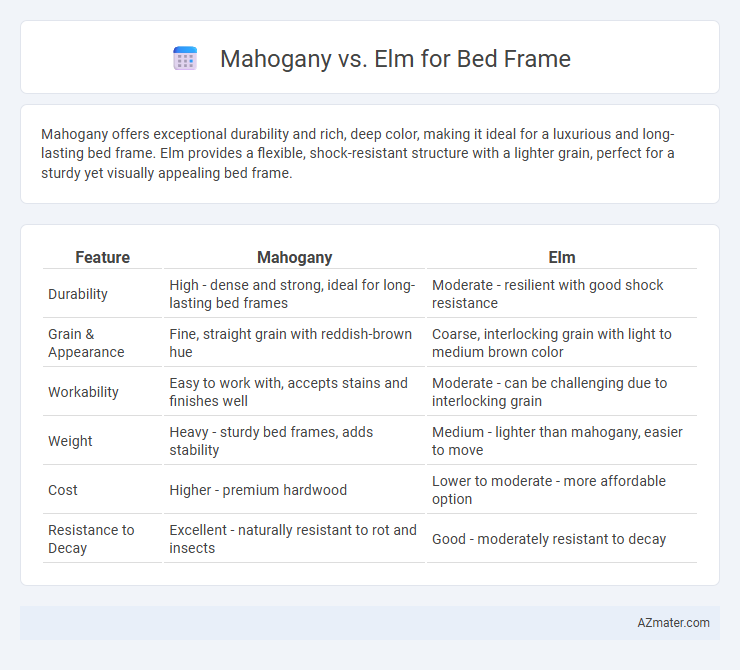Mahogany offers exceptional durability and rich, deep color, making it ideal for a luxurious and long-lasting bed frame. Elm provides a flexible, shock-resistant structure with a lighter grain, perfect for a sturdy yet visually appealing bed frame.
Table of Comparison
| Feature | Mahogany | Elm |
|---|---|---|
| Durability | High - dense and strong, ideal for long-lasting bed frames | Moderate - resilient with good shock resistance |
| Grain & Appearance | Fine, straight grain with reddish-brown hue | Coarse, interlocking grain with light to medium brown color |
| Workability | Easy to work with, accepts stains and finishes well | Moderate - can be challenging due to interlocking grain |
| Weight | Heavy - sturdy bed frames, adds stability | Medium - lighter than mahogany, easier to move |
| Cost | Higher - premium hardwood | Lower to moderate - more affordable option |
| Resistance to Decay | Excellent - naturally resistant to rot and insects | Good - moderately resistant to decay |
Introduction to Mahogany and Elm for Bed Frames
Mahogany offers exceptional durability and rich, reddish-brown hues, making it a premium choice for bed frames with a classic and elegant appearance. Elm wood is prized for its interlocking grain patterns and natural resistance to splitting, providing strength and distinctive texture ideal for rustic or contemporary bed designs. Both hardwoods are sustainable options, with mahogany delivering smooth finishes and elm offering a unique blend of sturdiness and aesthetic versatility for bed frames.
Appearance and Aesthetic Qualities
Mahogany features a rich, reddish-brown hue with a smooth, fine grain that imparts a luxurious and classic aesthetic to bed frames, often enhancing traditional or formal bedroom settings. Elm offers a lighter, golden to medium brown color with a distinctive interlocking grain pattern that creates a rustic and textured look, suitable for more casual or rustic decor styles. The choice between mahogany and elm influences the visual warmth and style sophistication of the bed frame, making mahogany ideal for elegance and elm perfect for natural charm.
Durability and Strength Comparison
Mahogany offers exceptional durability and strength, known for its dense grain and resistance to warping, making it an ideal choice for long-lasting bed frames. Elm, also durable, features interlocking grain patterns that provide impressive shock resistance and flexibility, reducing the risk of cracking under stress. Comparing both, mahogany delivers superior hardness and longevity, while elm excels in resilience and structural stability.
Weight and Workability
Mahogany is known for its moderate weight and excellent workability, making it easier to shape and carve for intricate bed frame designs. Elm is heavier and denser, offering superior strength but posing more challenges during cutting and joining processes. Choosing between mahogany and elm depends on whether you prioritize ease of machining or enhanced durability in a bed frame.
Resistance to Pests and Decay
Mahogany offers superior resistance to pests and decay due to its dense grain and natural oils, making it an excellent choice for long-lasting bed frames. Elm wood has moderate resistance but is more prone to insect attacks and fungal decay without proper treatment. Choosing mahogany ensures a durable, low-maintenance bed frame that withstands environmental challenges better than elm.
Cost and Affordability
Mahogany bed frames typically cost more due to the wood's density, durability, and rich reddish-brown color, making it a premium choice for high-end furniture. Elm offers a more affordable alternative with its moderate hardness and attractive grain patterns, providing durability at a lower price point. Choosing between mahogany and elm depends on budget constraints and preferences for long-term value versus initial cost savings.
Sustainability and Environmental Impact
Mahogany wood, known for its durability and rich color, often comes from slow-growing tropical trees, raising concerns about deforestation and habitat loss unless sourced from certified sustainable plantations. Elm wood, predominantly from temperate regions, typically grows faster and is more readily replenished, making it a more eco-friendly option with a lower carbon footprint when harvested responsibly. Choosing elm bed frames supports sustainable forestry initiatives and reduces environmental impact compared to mahogany, which requires stricter sourcing oversight to ensure ecological balance.
Maintenance and Longevity
Mahogany bed frames offer exceptional durability and resistance to wear, requiring minimal maintenance such as occasional polishing to maintain their rich color and smooth finish. Elm wood, while sturdy and flexible, tends to be more prone to scratches and dents, necessitating regular cleaning and protective treatments to enhance longevity. Both hardwoods can last for decades, but mahogany's natural oils and dense grain provide superior protection against environmental factors, making it a longer-lasting choice for bed frames.
Common Uses in Bedroom Furniture
Mahogany and elm are both popular woods used for bedroom furniture, with mahogany prized for its rich reddish-brown color and durability, making it a top choice for elegant bed frames. Elm is valued for its interlocking grain and resilience, often used in more rustic or traditional bedroom designs due to its natural texture and strength. Both woods provide sturdy support for bed frames but differ in aesthetic appeal and grain patterns, influencing their common applications in bedroom settings.
Which Wood Is Best for Your Bed Frame?
Mahogany offers exceptional durability, rich color, and natural resistance to decay, making it ideal for a luxurious and long-lasting bed frame. Elm features a distinctive grain pattern and excellent shock resistance, providing a sturdy and attractive option at a lower price point. Choosing mahogany ensures premium strength and elegance, while elm balances affordability with durability, helping you decide based on budget and aesthetic preferences.

Infographic: Mahogany vs Elm for Bed Frame
 azmater.com
azmater.com